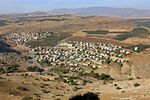Arab al-Mawasi massacre
On November 2, 1948, two squads of Israeli Defense Forces soldiers captured an encampment of Bedouins at Khirbat al-Wa'ra al-Sawda' in the eastern Galilee. While some soldiers guarded the Arabs, others went to a nearby hilltop where the headless bodies of two Israeli soldiers were found. In retaliation, the Arabs' dwellings were destroyed and 15 or 16 adult males were shot, 14 of whom died. The victims' bodies were buried in a cave adjacent to the place where they were killed. In the 1950s, the Israeli National Water Project was dug through the cave, and the Mawassi people took the bones to another cave. During the 1980s the bones were moved to a common grave in the Muslim cemetery in Eilabun.
Excerpt from the Wikipedia article Arab al-Mawasi massacre (License: CC BY-SA 3.0, Authors).Arab al-Mawasi massacre
Auf dem Esch,
Geographical coordinates (GPS) Address Nearby Places Show on map
Geographical coordinates (GPS)
| Latitude | Longitude |
|---|---|
| N 32.833055555556 ° | E 35.481944444444 ° |
Address
Auf dem Esch 5
26180 , Rastede I
Niedersachsen, Deutschland
Open on Google Maps









